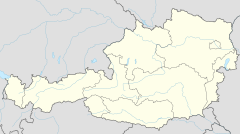Peterskirche, Vienna
This article needs additional citations for verification. (December 2021) |
| Peterskirche | ||
|---|---|---|
Year consecrated 1733 | | |
| Location | ||
| Location | Vienna, Austria | |
| Geographic coordinates | 48°12′33″N 16°22′10″E / 48.2093°N 16.3695°E | |
| Architecture | ||
| Architect(s) | Gabriele Montani (initial plan) Johann Lukas von Hildebrandt (modifications)[2] Kilian Ignaz Dientzenhofer (facade)[2] | |
| Type | Church[3] | |
| Style | Baroque | |
| Groundbreaking | 1701 | |
| Completed | 1733 | |
| Specifications | ||
| Direction of façade | SW | |
| Capacity | 400 | |
| Length | 50 metres (160 ft) | |
| Width | 20 metres (66 ft) | |
| Height (max) | 56.8 metres (186 ft)[2] | |
| Dome(s) | 1 | |
| Dome height (outer) | 54 metres (177 ft) | |
| Dome dia. (outer) | 30 metres (98 ft) | |
| Website | ||
| www | ||
The Peterskirche (English: St. Peter's Church) is a Baroque Roman Catholic parish church in Vienna, Austria. It was transferred in 1970 by the Archbishop of Vienna Franz Cardinal König to the priests of the Opus Dei.[4]
The first church
The oldest church building (of which nothing remains today) dates back to the

This church was replaced with a
The mediaeval church had three altars, with an apse in the south instead of the normal eastern orientation. This unusual feature has triggered many discussions among experts, and it is suspected that the church was adapted from a previously secular building. The church was surrounded by shops, and a nearby building housed the Stadtguardia, a forerunner of the modern police. The old church burned down in 1661 and was given only makeshift repairs. The decision to build a new church was taken up with the arrival of the Fraternity of the Holy Trinity of which the emperor Leopold I was a member. He had taken a vow to rebuild this church when Vienna was ravaged by the plague in 1679–1680.
The new building
The construction of the new

The turreted dome was mainly designed by Matthias Steinl, who was also responsible for the interior decoration and the pews with cherubic heads. The frescoes were originally painted by the Italian Andrea Pozzo, whose paintings were removed after his death.[clarification needed] As a result, in 1713, Johann Michael Rottmayr was able to start a completely new set. The fresco in the cupola represents the Coronation of Our Lady. On the triumphal arch one can see the coat of arms of emperor Leopold I. In the spandrels around the dome are portrayals of the four Evangelists and four Fathers of the Church, painted by the Viennese artist J.G. Schmidt. The same artist also painted the altarpiece in the side chapel of St. Michael.
The Baroque high altar was created by
The gilded pulpit is a work by Matthias Steinl (1726) having, on top of the canopy, a representation of the Holy Trinity. Opposite the pulpit there is a gold-and-silver representation of the Martyrdom of St. John of Nepomuk, sculpted by Lorenzo Mattielli. On top of it is a statue of The Mother of God.
Over the years, the paintings had become darker, and the interior began to take on a grey appearance. From 1998 to 2004, the church underwent a renovation, which returned the paintings to their original colouring and brightness.
Access
The Peterskirche is located on Petersplatz, right next to
See also
Gallery
-
Interior view from the gallery
-
Interior of Peterskirche
-
Detail of the dome's frescoes
-
Coronation of Our Lady fresco
-
The Heart of Mary in the side chapel of St. Antony
-
Baroque pulpit
-
Organ
-
Groundplan
References
- The information in this article is partly based on a translation of its German counterpart de:Peterskirche (Wien).
- St. Peter's Church, a small English guide - available in the church.
- Eyewitness Travel Guides - Vienna (in Dutch translation : Capitool reisgidsen: Wenen); Dorling Kindersley Ltd. Londen, 1994 ISBN 90-410-1808-5
Notes
- ^ "Official website of the Peterskirche (Vienna, Austria)". Official website. Rektoratskirche St. Peter. Retrieved 2007-10-22.
- ^ a b c "History of the Peterskirche (Vienna, Austria)". Official website. Rektoratskirche St. Peter. Archived from the original on 2008-10-15. Retrieved 2007-10-22.
- ^ "St. Michael Pfarre" (in German). Erzdiözese Wien. Retrieved 2007-11-12.
- ^ "Geschichte und Einrichtungen des Opus Dei in Österreich". Official website (in German). Opus Dei Information Office. Archived from the original on 2007-10-28. Retrieved 2007-10-22.
External links
 Media related to Peterskirche at Wikimedia Commons
Media related to Peterskirche at Wikimedia Commons- Official website











